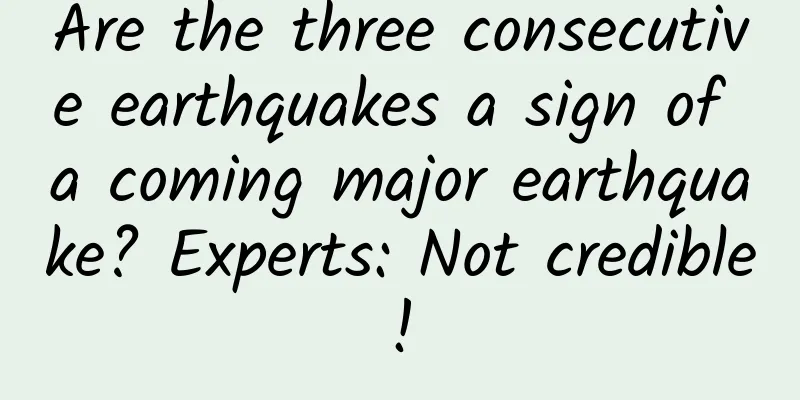Are the three consecutive earthquakes a sign of a coming major earthquake? Experts: Not credible!

|
Today (February 9), earthquakes occurred successively in three places in our country. A 3.0 magnitude earthquake occurred in Xinghua City, Taizhou City, Jiangsu Province According to the official measurement of the China Earthquake Networks Center, a magnitude 3.0 earthquake occurred at 7:00 on February 9 in Xinghua City, Taizhou City, Jiangsu Province. The focal depth was 8 kilometers and the epicenter was located at 32.72 degrees north latitude and 120.17 degrees east longitude. A 3.1-magnitude earthquake occurred in Manzhouli, Hulunbuir, Inner Mongolia According to the official measurement of the China Earthquake Networks Center, a magnitude 3.1 earthquake occurred at 6:16 am on February 9 in Manzhouli City, Hulunbuir City, Inner Mongolia. The focal depth was 10 kilometers and the epicenter was located at 49.55 degrees north latitude and 117.64 degrees east longitude. A 3.6-magnitude earthquake occurred in Shaya County, Aksu Prefecture, Xinjiang According to the official measurement of the China Earthquake Networks Center, a magnitude 3.6 earthquake occurred at 0:12 on February 9 in Shaya County, Aksu Prefecture, Xinjiang. The focal depth was 20 kilometers and the epicenter was located at 41.06 degrees north latitude and 83.44 degrees east longitude. Are the continuous small earthquakes a precursor to the coming big earthquake? There is a traditional proverb in my country that goes, "A small earthquake is followed by a big earthquake." This proverb means that a small earthquake will inevitably be followed by a big earthquake, and it has long been regarded as the golden rule for predicting big earthquakes empirically. Does this proverb have any scientific basis? In fact, the proverb is not a scientific truth. The latest scientific research has found that this proverb is not true. Statistics show that in my country, this type of "foreshock-mainshock" earthquake activity series with the characteristics of "small earthquakes causing noise, and large earthquakes coming" is extremely rare, accounting for less than 10% of the total earthquakes, that is, the accuracy of this empirical prediction is less than 0.1, which is probably lower than the accuracy of guessing. According to mathematical probability theory, at least 22 predictions are needed to have a chance of a successful prediction. The logical fallacy behind the proverb But this proverb or experience does exist, how to explain it? This actually involves a logical reasoning error! That is, necessary conditions are not necessarily sufficient conditions. Because some major earthquakes do occur before a series of small earthquakes, the frequency can reach dozens to hundreds of times a day. In the historical records of earthquakes, many earthquakes have recorded obvious foreshock activities, such as the 7.3-magnitude Haicheng earthquake in Liaoning, China in 1975. Before this major earthquake, there were constant small earthquakes, and the frequency and intensity of small earthquakes became higher and higher. At the highest point, the frequency of small earthquakes could reach 1 per minute. However, this only shows that small earthquakes are a necessary condition for large earthquakes, that is, there will be small earthquakes before large earthquakes, and it cannot be concluded that "a large earthquake will definitely follow a small earthquake", that is, small earthquakes cannot be a sufficient condition for large earthquakes. To give an example from common sense in life, some people will feel chills all over before a cold breaks out, but we cannot assume that we will catch a cold every time we feel chills. In other words, a necessary condition is not necessarily a sufficient condition, and we cannot deduce in reverse! Copyright images in the gallery. Reprinting and using them may lead to copyright disputes. Those scientific facts that go against common sense (1) Small earthquakes are not small. In science, a small earthquake is one with a magnitude of less than 2.5, which is generally not felt by humans and can only be detected with professional seismic instruments. The small earthquakes we usually refer to are actually felt earthquakes in science, which refer to earthquakes with a magnitude between 2.5 and 4.7. In terms of energy level, for every 1.0 magnitude difference in magnitude, the energy difference is about 30 times, so the small earthquakes we usually refer to are not small at all. (2) Small earthquakes are actually very frequent. There are about 5 million earthquakes in the world every year. Tectonic earthquakes that can cause major disasters only account for a small part of the world's earthquakes. People can feel about 50,000 earthquakes, which means that we can't feel the vast majority of earthquakes at all. To put it bluntly, earthquakes are actually shaking and moving all the time, so we don't need to be disturbed by the occasional small earthquakes we feel. We can let the "bullet" fly for a while. (3) Small earthquakes are actually aftershocks. What we call "continuous small earthquakes" in daily life may actually be just aftershocks of the last ancient earthquake, rather than the beginning of a new earthquake. You may be curious, why are there still aftershocks after more than 20 years? Because the concept of time in geology is different from our concept of time. 20 years is already a long time for humans, but compared with the geological units of tens of thousands or millions of years, 20 years is simply not worth mentioning. The correct logical relationship behind small and large earthquakes Every year, more than 5 million earthquakes occur on Earth, and small earthquakes are very frequent in many places. Long-term earthquake monitoring has found that although it is unreliable to use "small earthquakes, big earthquakes are coming" to predict earthquakes, and there is a lot of uncertainty, small earthquakes are not completely useless, and they also have certain monitoring significance. That is, the indicator of small earthquakes can also be regarded as an indicator of earthquake prediction, but it cannot be used alone, but should be used in combination with other indicators to verify each other, which is meaningful. That is, when predicting a major earthquake, in addition to mastering the frequency of small earthquakes, it should also be further combined with seismic activity, geophysics and geochemistry data for comprehensive analysis and joint judgment, and multi-indicator consultation and judgment. No matter whether the earthquake is big or small, you must hide Regardless of whether it is a big earthquake or a small earthquake, and whether there is an earthquake warning or not, we should take shelter during an earthquake. The safety of human life always comes first. We can receive earthquake warning information through the mobile phone settings. At present, the mainstream domestic mobile phone brands in my country have built-in this function. It should be emphasized that earthquake warning is not an earthquake forecast, but an alarm. When you receive the warning information, it means that the earthquake has occurred and is coming soon. Usually there are only a few seconds to tens of seconds of emergency disposal and evacuation time. Therefore, after receiving the warning, friends must not worry about whether it is a small earthquake or a big earthquake, but at the first time, the best strategy is to "hide". How and where to hide when an earthquake comes? Step 1: Where to run? Evacuate immediately and run to an open area. If you are on a high floor, find sturdy furniture or walls for cover to reduce the risk of being hit by falling objects. Step 2: Hold on tight After finding a relatively safe shelter, be sure to hold on to a solid or fixed object to avoid secondary injuries caused by movement. Step 3: Take good protection When dodging, use books, backpacks, pillows, cushions and other coverings to protect important parts such as the head and back of the neck to reduce the chance of injury. In the process of dodging, you also need to avoid the following misunderstandings and remember a few "no": ①Don’t hide in the elevator; ② Do not hide under hanging objects such as chandeliers and electric fans; ③ Do not hide near large wardrobes or other cabinets. ④Do not get close to stoves, gas pipelines and household appliances; ⑤Do not get close to windows, glass curtain walls and building exterior walls; ⑥ Do not hide under trees or electric poles; 7. Do not hide under cliffs; ⑧ Do not hide on or under bridges; 9. Do not rush to the streets or roads to escape; ⑩Don’t hide in the car. Millions of small earthquakes occur on Earth every year, most of which are imperceptible earthquakes that humans cannot feel. For example, in 2023, there were 561 earthquakes with a magnitude of 3 or above in mainland China, of which 549 were below 5, accounting for 98%, so we don't need to worry too much. At the same time, most of our current buildings are reinforced concrete frame structures with high earthquake resistance levels. High-rise buildings in cities are generally designed to withstand magnitude 8 earthquakes, so there is no need to worry about small earthquakes. At present, my country is carrying out a new round of urban renewal and renovation of old communities. Brick-concrete communities with low earthquake resistance levels are gradually being eliminated or demolished. In addition, from a historical perspective, my country has a vast territory and is affected by the southeastern Pacific Rim seismic belt and the southwestern Mediterranean-Himalayan seismic belt. It has been a country with many earthquakes since ancient times, and the recorded history of earthquakes is more than 3,000 years. About one-quarter to one-third of the major earthquakes in the world's continental regions occurred in my country, so we don't need to be afraid of "earthquakes", but should objectively and calmly understand and explore them and analyze the scientific truth behind them. Author: Liu Hanbin, PhD in Geology, Senior Engineer Reviewer: Zhang Ying, Director of the China Science Writers Association, Executive Vice Chairman and Secretary General of the Emergency Science Popularization Committee Produced by: Science Popularization China The cover image of this article comes from the copyright library. Reprinting and using it may cause copyright disputes |
Recommend
What gifts are healthier for the Spring Festival?
China is a country of etiquette, where we believe...
95% of humans are silently infected: There is no vaccine for this virus that can cause terminal illness
Statistically speaking, the Epstein-Barr virus (a...
Improve conversion rate: How to make App [preview video]?
[Preview video] is a new feature provided by Appl...
BMW has Jaguar Land Rover disease, the 180,000 yuan i3 broke the hearts of Audi, Mercedes-Benz and Porsche
Among the new energy vehicle models launched by M...
Squeeze the toothpaste! You will still be disappointed with Intel's 8th generation Core processors in 2018
Not long ago, a technology website called BenchLif...
Smartphones may soon be able to monitor your breathing during sleep
Researchers say they have come up with an accurat...
8 dietary tips to prevent cardiovascular disease, but many people don't follow them
A friend chatted with Huazi and asked a question....
B-side product operations: a guide to avoiding pitfalls in demand management
The methods of demand collection, analysis, and i...
Today is the Winter Solstice | Snow is falling outside the window in the dead of winter, and the house is warm and cozy
"The stars turn and the frost spreads overni...
Female star's possession of e-cigarettes has aroused concern! E-cigarettes are not a "safe haven" and their harm cannot be underestimated →
Recently, the incident of "a female star hid...
Which matching mode is best for Baidu bidding promotion?
New friends who are doing bidding promotion will ...
Google’s Li Cong: How was the “6 9s” operation and maintenance achievement achieved?
On April 14-15, 2016, the WOT2016 Internet Operat...
Chronic patients don't have to worry about winter! 6 "magic weapons" to warm the body and heart, family members must read
1. Dress like an onion, wrap yourself tightly lay...
How to improve ROI? Internet marketing combination methodology!
This article will focus on the general Internet m...
Get APP: Analysis of the operation and promotion strategies behind the development of knowledge service providers
This article takes product status, user growth an...









